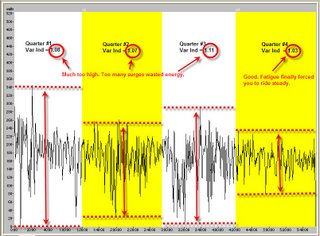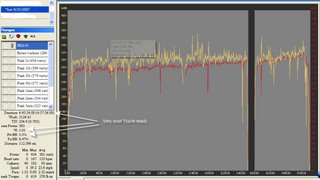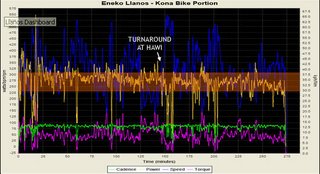The Most Common Ironman Mistake
In Kona this year I met an age-group athlete the day before the race. Nice guy. After the race he wrote me with a question about his race. He also sent me his WKO+ power-data file. You can see it below. What I saw is typical of most Ironman athletes. It’s easy to fix but requires dedication as it isn’t what you want to do in a race. The other chart you see farther down is explained in my answer.
Question: I have been training with power (bike) and GPS (run) throughout this year and have felt as though I had nailed my plan down. On my bike, I did a bunch of rides 4:30-6:00 and was able to maintain 200-220 watts (I usually don’t use normalized power because I can’t see it on my computer). Also, my critical power is around 290. I use the 20 minute all out and the 3 minute all out to calculate this. I had registered for Ironman Florida as well so I really didn’t want to push too hard and have nothing left. I figured I would stay around 200-210-ish to be safe. Coming out of the swim and going to the bike my legs felt pretty tired. I was able to keep the watts up in the beginning but it really felt like I was pushing a lot harder than what my watts were showing. By mile 40 I started cramping in my VMO on both legs. This went on for the next several miles and got worse. At this point all goals went out the window and it was a race of survival at that point. My average power was 169 and normalized power was 179 (which is the lowest long ride I have done in months). I was hoping to finish the bike in 5:30 but only managed 5:57...which I was actually happy with considering the conditions of the race and my body. I felt good from a nutrition standpoint. I think I was a little dehydrated but not by much (i urinated before the bike and 2x on the bike and none on the run). Of course, the bike killed my run as well. I was hoping for a 3:45 run (which I have done before). In my previous ironman races I have been sore for the whole week. Two days after the race I was stiff but not bad and think it may have been due to my flight home more than the race. Four days out I felt great.  I was totally baffled by this result and wondered am I asking too much out of myself? Could the conditions of heat and wind have that much of an effect on my performance or am I missing something here?
I was totally baffled by this result and wondered am I asking too much out of myself? Could the conditions of heat and wind have that much of an effect on my performance or am I missing something here?
Answer: It’s always a bit difficult to draw conclusions from just one piece of data even if it is over nearly 6 hours. Having heart rate in addition to power would have been good to see what you were experiencing effort-wise and to get some idea of what the heat was doing to you, also. I would like have seen how much cardiac drift/decoupling was going on. That can be found on the “graph” view of WKO+ where it says “Pw:HR.” But I’m fairly confident I see the cause of your demise on the bike. It has to do with variability index. I see this a lot and spend months teaching the athletes I train how to control it by working on pacing while staying very focused on power in training and races.
Variability index (VI) is normalized power divided by average power. The resulting ratio should be less 1.05 I’ve found in long course racing. Your average VI for the entire race was 1.08. Much too high. Looking at it by quarters reveals even more. That’s what the chart attached shows. In Q1 VI was 1.08, Q2 it was 1.07 and in Q3 climbing to Hawi and descending it was 1.11. For 84 miles of the race you were averaging 1.09 for VI. It didn’t drop back down into the goal range of less than 1.05 until the final quarter when fatigue set in and forced you to ride steady.
What these VI numbers tell me is that you were surging a lot—in and out of corners in town, into head wind, up and down small hills, when someone passed you or you passed others, etc. Surges sap you of energy very quickly and also play havoc with your gut’s processing of fluid and fuels. Steady state pacing is a far better use of your energy. I expect your long rides did not have nearly this high of a VI. They, just like your race, should have a VI less than 1.05. Until you can do that it is unlikely that you will ever produce your best possible long course ride.
Also attached is a chart from an athlete I used to coach who was the best I’ve ever worked with for low VI scores. Here he does 112 miles in training in 4:44 with a VI of 1.01. He raced exactly the same as he trained. There was never any question that he would have a good IM ride. This is exactly what you need to work on doing also. Make your rides exactly like what you expect to do in the race – as much as possible. Terrain and weather may confound the preparation a little but you need to decide how to handle those also relative to your power. Once you learn to ride this same way you’ll have good races without issues, at least not on the bike. You mentioned that you didn’t see any way to ride normalized power in the race. Actually, you can. If you ride at a steady power output of VI less than 1.05 the average power on your device will be almost the same as normalized power. In fact, what you should do is to set a race power goal based on the NP from your long rides in the last several weeks before the race. So if you determine that an appropriate NP is, say, 200w then you just ride steadily trying to average 200w. At less than 5% VI your range would wind up being +/- 10w or less. But realize that the goal number you come up with must be based on actual training data, not what you think you are capable of. That’s a whole other discussion.
You mentioned that you didn’t see any way to ride normalized power in the race. Actually, you can. If you ride at a steady power output of VI less than 1.05 the average power on your device will be almost the same as normalized power. In fact, what you should do is to set a race power goal based on the NP from your long rides in the last several weeks before the race. So if you determine that an appropriate NP is, say, 200w then you just ride steadily trying to average 200w. At less than 5% VI your range would wind up being +/- 10w or less. But realize that the goal number you come up with must be based on actual training data, not what you think you are capable of. That’s a whole other discussion.
 The chart is a bit hard to read. The only part that really tells us anything here is the power graph, the yellowish line across the middle. Unfortunately, there was no heart rate data.
The chart is a bit hard to read. The only part that really tells us anything here is the power graph, the yellowish line across the middle. Unfortunately, there was no heart rate data.
